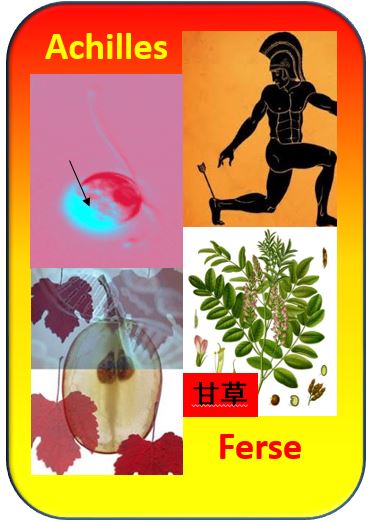2017_03 Achilles Heel of a Grape Killer
What is the topic?
Achilles, the invincible hero of the Greeks, died during the battle of Troj from a poisoned arrow in his heel, the only spot of his body, where he was vulnerable. Also Plasmopara viticola the cause of Grapevine Downy Mildew has his Achilles Heel: during its early development, when the flagellated zoospores hatches and searches its path on the rain-wetted surface of grapevine leaves to search for stomata as entry sites into its plant host. During this early 15 min of a new life cycle, the cell is naked and has to pump out penetrating water by means of a contractile vacuole. If this vacuole were inhibited, the cell would swell and eventually burst.
This is exactly what happens, what the traditionally used copper preparation (the famous Bordeaux Broth) is doing. In ecological viticulture, where systemic fungicides are not allowed, this is still used today. This is not really “eco”, because copper is a heavy metal, accumulating in the soil and damaging soil organisms, such as annelids.
Strategy: explore the Achilles Heel
To find ecologically compatible alternatives for copper, we first have scrutinised the function of the Achilles Heel in Plasmopara. This is far from trivial, because these cells are very mobile and do not stand still, just to be observed. A combination of electron, confocal, and video microscopy was successful in revealing some of the secrets of the contractile vacuole. For instance, we were able to see that first lacunae of a spongy structure (the so called spongiome) interact with actin. Actin is also the building block of our muscles and can generate force in concert with the molecular motor myosin. By contraction of these cellular muscles, the water that had entered into the cell is squeezed into the lacunae of the spongiome and is then collected in the vacuole itself, which is connected with the environment through a pore. The vacuole swells and is emptied around every 5 sec, such that it relaxes again.
What does this knowledge give us?
When the cell uses actin to press water through the membrane out of the cell, an inhibition of actin activity should cause a burst of the zoospore. This is, what we see, when we use appropriate inhibitors. For viticulture, this would not work, because these inhibitors are very expensive. Metal ions, especially copper or aluminium, have the same effect. But, again, this would not be meaningful – the goal is to find ecologically safe alternatives for these heavy metals, even though the dose needed for this effect, is extremely low. The fact that the effective dose is very low, tells us that copper or aluminium do not really poison the cell, but rather act as (misleading) signals. At this stage, we could profit from our long expertise on the regulation of plant actin – actin filaments are very responsive to many environmental signals. The signalling input is a certain protein in the cell membrane, the NADPH-Oxidase Respiratory burst oxidation homologue (RboH), which generates reactive oxygen species in response to environmental signals. These oxygen species induce than a bundling of actin (“muscle contraction”). Copper and aluminum can generate the same reactive oxygen species and thus act as actin-bundling signals.
A crazy idea leads to success
If copper acted by generation of reactive oxygen species and thus simulates the activity of RboH, it would mimick a signal leading to a contraction of actin “muscles”, which would be deathly, because it occurs at the wrong time. When this bold idea is valid, a burst of the cells should also be elicited by other compounds that can activate RboH. With this idea, we mined the knowledge of Traditional Chinese Medicine (TCM), more specificially with the medicinal plant Glycyrrhiza uralensis, a relative of our licorice. Extracts from this plant, called Gan Cao, are used to soothe asthma and bronchitis, because they can modulate the contraction of the muscles in the respiratory tract. In fact, a standardised extract of Gan Cao from the company Phytocomm in Kehl was able to “persuade” the zoospores of Downy Mildew to burst. The putative active ingredient of Gan Cao, a complex molecule called glycyrrhizin, was also effective. To test, whether the mode of action of Gan Cao really runs via the activation of RboH, we have tested, what happened, when the RboH is blocked – this can be done efficiently and specifically by the inhibitor diphenylene iodonium. In fact, the effect of Gan Cao on Downy Mildew was blocked by this inhibitor – our first apparently very bold idea began to substantiate.
The next step – TCM for the vineyard?
In 2016, the German viticulture was challenged by an extreme attack of Downy Mildew. A humid and relatively warm May generated ideal conditions for this ill-doer, which had come to Europe more than a century ago from North America. In some places, every week a fungicide treatment was needed to save at least a part of the harvest. For the ecological viticulture, this meant a high input of copper into the environment. Could we use, instead of copper, extracts from Gan Cao? Experiments with licorice at the Julius-Kühn-Institute in Darmstadt at the Cucumber Downy Mildew showed effect even in field studies, although the cause for this effect has remained enigmatic. For the use in viticulture, the efficiency is not sufficient, the compound has also to stick to the leaves. By a high content of mucous compounds, Gan Cao extracts are pretty sticky and form a rainfast film around the leaves. The seemingly crazy idea to treat vineyards with Traditional Chinese Medicine, at a second glance turns out at to be not crazy at all.
Publication
131. Tröster V, Setzer T, Hirth T, Pecina A, Kortekamp A, Nick P (2017) Probing the Achilles' Heel of the Biotrophic Grapevine Pathogen Plasmopara viticola. Protoplasma DOI: 10.1007/s00709-017-1123-y - pdf

